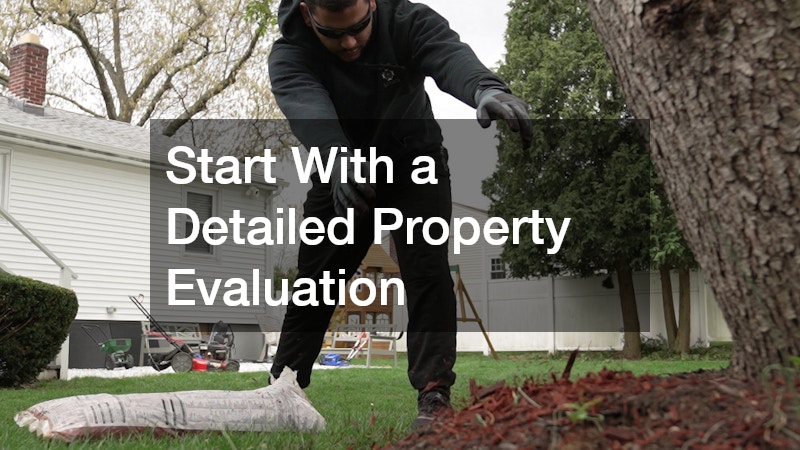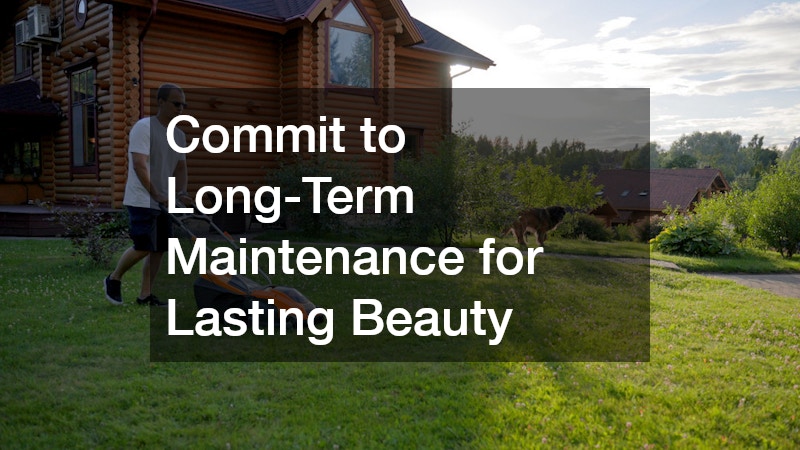Creating a stunning landscape design is more than choosing pretty plants or adding decorative stones. It requires an understanding of how outdoor spaces function, how natural and structural elements interact, and how to shape land in a way that supports long-term health and beauty. A truly successful design enhances curb appeal, boosts property value, and makes daily outdoor living more enjoyable. It also accounts for your local climate, existing terrain, functional needs, and vision for how the space should feel. This guide walks you through everything from evaluating your property and shaping the land to installing hardscape, planning drainage, incorporating lighting, and maintaining harmony over time. Whether you’re updating a small yard or designing an expansive garden, you’ll find step-by-step strategies to help you build a landscape that is both beautiful and practical.
Start With a Detailed Property Evaluation
Before you begin shaping or planting anything, take time to understand your property’s layout, sun patterns, and soil characteristics. Early evaluation helps prevent costly mistakes and gives you the foundation for a strong, cohesive design. A thorough assessment also helps you anticipate how your landscape will behave throughout the year, ensuring your finished space functions smoothly rather than requiring expensive corrections later. The more precise your understanding of the environment, the easier it becomes to choose the right plants, position hardscape wisely, and design outdoor areas that age gracefully.
What to analyze:
- Sun exposure patterns throughout the day and across seasons: Observe which areas receive full sun, partial sun, or deep shade. Note how these patterns shift between summer and winter. This information determines where to place shade-loving plants, sun-demanding gardens, outdoor seating, and heat-sensitive features like fire pits or metal décor.
- Wind direction and areas prone to harsh gusts: Strong winds can dry out soil, damage plants, and make certain areas uncomfortable for gathering. Identify natural wind tunnels around your home, as well as sheltered pockets that may benefit from seating or delicate plantings.
- Existing vegetation and what it tells you about soil conditions: The plants already thriving on your property give valuable clues about moisture levels, pH balance, drainage, and soil type. For example, moss may indicate heavy shade and compacted soil, while hardy shrubs could suggest well-drained areas.
- Slopes, dips, or uneven areas affecting usability: Uneven terrain influences water flow, erosion risk, and your ability to build patios, pathways, or play areas. Mapping these variations helps you plan grading, terracing, or soil redistribution later.
- Foot traffic habits that naturally form on your property: Look for informal paths where people already walk. Designing around these patterns prevents soil compaction and helps you build intuitive walkways that enhance usability rather than forcing inconvenient detours.
Bring in land surveying services if you’re unsure about boundaries, slope severity, or grade changes. This professional insight ensures you know exactly where property lines fall, how steep or irregular specific areas are, and whether certain features will require engineering adjustments. This is especially important for large projects involving patios, retaining walls, or outbuildings, where improper measurements can compromise safety and lead to costly rework. When you combine technical insight with personal observation, you’ll create a design grounded in accuracy rather than guesswork, giving you the confidence to move forward with each phase of the project.
Including an excavation contractor early in this planning phase can also help you understand what’s feasible when reshaping terrain or preparing for major installations. These professionals can evaluate soil stability, identify whether clay, sand, or loam dominates certain areas, and determine how that will affect drainage and structural support. They can also point out access points for heavy equipment, potential underground obstacles, and safety concerns you may not notice on your own. By consulting them early, you reduce the risk of unexpected delays and ensure your design goals align with the physical realities of your property.
Establish a Vision and Define Your Landscape Goals
A stunning landscape begins with a clear, well-defined vision. Knowing how you want your outdoor space to look and function will guide every decision you make.
Questions to clarify your goals:
- Do you prefer a modern, low-maintenance landscape or a lush, garden-centric layout?
- Will the space be used primarily for entertainment, relaxation, gardening, or play?
- What colors and textures appeal to you?
- How much time are you willing to dedicate to upkeep?
Consider assembling a vision board—digital or physical—with inspiration photos, material samples, and plant palettes. This visual reference keeps your design consistent as you move through the process.
If your project involves major land restructuring, consult reputable excavating companies early on. They can help evaluate how feasible your goals are based on the property’s terrain. Integrating that professional insight into your planning helps you avoid creating a design that looks good on paper but is impractical to implement.
Develop a Functional Layout That Supports Daily Living
Your landscape layout should promote smooth movement, comfortable gathering spaces, and functional activity zones. Avoid layouts that look beautiful but cause bottlenecks, lack privacy, or feel disjointed. A well-planned layout feels intuitive, allowing people to walk through the space naturally without confusion or obstruction. It should guide movement, highlight focal areas, and support everyday activities without forcing awkward detours or limiting usable space. The goal is to create an outdoor environment that feels cohesive and balanced—a place where every element has a purpose and contributes to the overall flow.
Key elements of a functional layout:
- Primary walkways: Wide enough for comfortable use
- Secondary paths: For accessing gardens, utilities, or side yards
- Entertainment areas: Patios, fire pits, or outdoor kitchens
- Quiet zones: Benches, shade trees, or small reading nooks
- Utility zones: Trash storage, tool sheds, or workspaces
Integrating land grading services ensures your layout supports proper drainage and feels level and safe for daily use. Uneven or poorly graded terrain can cause slippery surfaces, stress on retaining walls, and long-term erosion that undermines both hardscape and plantings. Whether you’re installing a patio or constructing pathways, proper grading prevents water pooling, soil erosion, and future maintenance headaches. It also helps direct water away from foundations and toward appropriate drainage areas, preserving the health of both structures and surrounding plants.
Large installations—like raised terraces, walls, or ponds—often require an excavator to shape soil efficiently. Professional equipment allows for precise movements, deeper digging, and accurate sculpting of the land, especially in areas too compacted or large to shape by hand. Proper equipment use saves time, prevents safety risks, and protects the integrity of your long-term design. Using the right machine reduces soil compaction in surrounding areas and minimizes disruption to established plants or structures. For complex projects, operating an excavator with professional oversight ensures the work meets engineering and safety standards, giving you confidence that your landscape will remain stable and functional for years to come.
Plan for Water Flow and Drainage Early
Water management is one of the most overlooked aspects of landscape design, yet it’s essential for plant health, foundation protection, and overall functionality.
Key drainage strategies:
- Swales to guide water across the property
- French drains to move water away from structures
- Rain gardens that absorb excess runoff
- Dry creek beds for decorative yet functional flow channels
Pay close attention to how ground water behaves during heavy rainfall or seasonal shifts. Poor drainage can drown plants, damage soil structure, and weaken foundations.
If you’re planning to install new water lines—such as irrigation or outdoor sinks—bringing in a residential plumber ensures everything meets code, functions efficiently, and integrates safely with your larger landscape design.
Shape the Land to Match Your Design Vision
Contouring the land adds dimension, character, and functional value to your landscape. Whether you want rolling hills, terraced gardens, or a perfectly flat recreation area, strategic shaping makes it possible.
Land shaping options include:
- Building berms for privacy and visual interest
- Excavating sunken patios for a cozy, protected feel
- Terracing slopes to support planting and prevent erosion
- Flattening high areas for lawns or entertainment spaces
Land shaping often requires collaboration with an experienced landscaping company to ensure structural stability and aesthetic cohesion. They can help you visualize how changes affect plant placement, drainage, and accessibility.
Access to the right masonry supplies is also important if your shaping plan includes retaining walls, stone steps, or structural borders. High-quality materials ensure your hardscapes withstand the elements and blend seamlessly with your surrounding landscape.
Build Hardscape That Anchor the Design
Hardscape—patios, walkways, fire pits, pergolas—create structure, functionality, and visual rhythm in a well-designed landscape. They’re the backbone of outdoor living spaces.
Popular hardscape materials:
- Natural stone
- Pavers
- Brick
- Concrete
- Decorative gravel
When building hardscape, consider:
- Durability: Materials should withstand weather changes
- Texture: Surfaces should provide traction in wet conditions
- Color palette: Should harmonize with home exterior
- Scale: Proportions should fit the space naturally
Selecting the right masonry supplies ensures your hardscape installations last and remain visually appealing. If your hardscape construction involves moving large amounts of soil or debris, coordinating with a dumpster rental service can make cleanup faster, safer, and more efficient, especially for multi-day projects.
Choose Plants That Match Your Environment and Style
Plant selection has a major impact on the overall aesthetic and long-term maintenance requirements of your landscape. Choose species that thrive in your region and work well with your soil type, sun exposure, and water availability.
Plant selection tips:
- Use native plants for drought resistance and low maintenance
- Mix evergreens and deciduous shrubs for year-round interest
- Layer plants by height for depth and texture
- Add seasonal color with perennials and ornamental grasses
- Avoid overcrowding to reduce disease and root competition
Group plants based on watering needs to avoid unnecessary waste and keep your landscape healthy with minimal effort. When selecting trees, consider their mature height and root spread to prevent future conflict with structures or hardscapes.
Create Focal Points That Elevate Your Landscape’s Personality
Focal points bring instant visual interest, guide the eye, and create memorable moments within your landscape. They help break up large areas and give meaning to transitions between spaces.
Effective landscape focal points include:
- Sculptures or artistic installations
- Water features such as fountains or small ponds
- Large specimen trees
- Oversized planters
- Decorative seating or pergolas
- Clusters of vibrant plantings
Placement is just as important as the focal point itself. Install features where they anchor a space, break visual monotony, or highlight a transition in the layout. Avoid overusing focal points—one per major zone is usually ideal. Too many can overwhelm the landscape and reduce the overall impact.
Improve Lighting and Outdoor Ambiance
Outdoor lighting enhances safety, beauty, and nighttime functionality. It also draws attention to the most attractive features of your landscape while keeping pathways and gathering spaces usable after sunset.
Types of outdoor lighting to consider:
- Pathway lighting: Prevents trips and highlights walkways
- Uplighting: Adds drama to trees, architecture, or large shrubs
- Downlighting: Creates softer, natural illumination
- String lights: Perfect for entertainment areas
- Motion lighting: Boosts safety and security
A thoughtful lighting design balances aesthetics and function, avoiding overly harsh beams or excessive brightness. Layer your lighting just as you would indoors, using a combination of low, medium, and high-intensity fixtures to create a warm, inviting nighttime environment.
Commit to Long-Term Maintenance for Lasting Beauty
Even the most beautifully designed landscape can deteriorate without proper upkeep. Maintenance ensures every aspect of your design continues looking its best while functioning safely and efficiently.
Landscape maintenance checklist:
- Seasonal pruning to maintain plant health and shape
- Mulching to regulate soil temperature and reduce weeds
- Weeding and cleaning beds to prevent disease
- Inspecting hardscape for cracks or shifting
- Fertilizing strategically based on plant needs
- Refreshing gravel or mulch when faded or compacted
Consider seasonal evaluations to adjust watering, replace failing plants, and refresh worn areas. A well-maintained landscape grows more beautiful over time and delivers a strong return on your investment.
A stunning landscape design doesn’t happen by accident—it requires planning, creativity, and a practical understanding of how natural and structural elements work together. By evaluating your property carefully, defining your goals, shaping the land intentionally, choosing functional layouts, and installing thoughtful hardscapes and softscapes, you can build an outdoor environment that supports everyday life while elevating your home’s appearance. With proper lighting and consistent maintenance, your landscape will continue to evolve, mature, and provide long-lasting beauty and enjoyment. Whether you’re tackling a small backyard refresh or a full-scale redesign, the strategies in this guide will help you craft a landscape that feels personalized, purposeful, and truly stunning.




